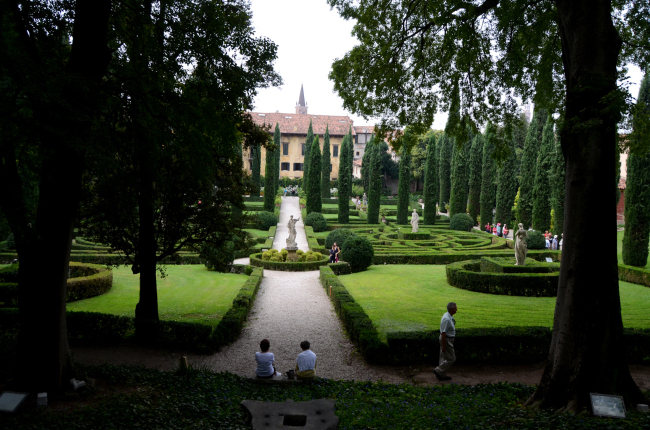Italy’s Giusti Garden is magical mix of chaos and order
By Korea HeraldPublished : Jan. 23, 2015 - 21:21
VERONA, Italy ― A huge angry stone face looks down on visitors through giant spires of cypress trees at Giusti Garden. The intimidating mascherone was originally designed to breathe fire, probably the only thing that could make it more foreboding. It was just one of the surprises I and 32 other gardeners found on a 10-day trip in September to visit gardens of Northern Italy.
Gently sloping trails led to a grotto at the top of the mascherone. On the way, we saw an array of beautiful plants, some of which I’d never seen before. A hummingbird moth danced from flower to flower, gathering nectar from low-growing blue plumbago that softens the trail’s edges. Pale pink begonias grew wild along an ancient rock wall next to a stone bench amid swaying white windflowers. After the short trek, we were rewarded by stunning views of the main garden path and Verona itself. Shakespeare set three of his plays in the city, including “Romeo and Juliet.” The Guisti family has owned the palace since the 16th century, and the gardens were created in 1580.
We reached the summit at just the right time. The cheerful, high-pitched songs of birds hidden in the thick green foliage joined at noon with those of church bells, creating a lovely symphony. As we worked our way downhill along a winding stone path, we caught another bit of music ― the sounds of a piano drifting out of the windows of an adjoining school. It was magical.
Gently sloping trails led to a grotto at the top of the mascherone. On the way, we saw an array of beautiful plants, some of which I’d never seen before. A hummingbird moth danced from flower to flower, gathering nectar from low-growing blue plumbago that softens the trail’s edges. Pale pink begonias grew wild along an ancient rock wall next to a stone bench amid swaying white windflowers. After the short trek, we were rewarded by stunning views of the main garden path and Verona itself. Shakespeare set three of his plays in the city, including “Romeo and Juliet.” The Guisti family has owned the palace since the 16th century, and the gardens were created in 1580.
We reached the summit at just the right time. The cheerful, high-pitched songs of birds hidden in the thick green foliage joined at noon with those of church bells, creating a lovely symphony. As we worked our way downhill along a winding stone path, we caught another bit of music ― the sounds of a piano drifting out of the windows of an adjoining school. It was magical.

One thing I love about many European gardeners is the way they embrace weeds, letting them bloom in the right spots. The tiny flowers of wild yellow mustard were the perfect foil for the blue blossoms of the plumbago. In a formal garden, they would have been eliminated because they aren’t a cultivated species.
Our descent offered yet another different view of the center garden. Cypress trees reached for the sky, creating axis points for the long paths. Neatly trimmed topiary, a maze and huge, beautifully planted containers are all things expected in a great Italian garden like this one. We could get a close look at the many statues or take a seat and listen to the cascading water of the fountains.
As we kept walking, we were greeted with another surprise: Only in Italy could you find a long line of clay pots filled with different colored lantana blooms, perched single file on a weathered rock wall. The simple beauty of the presentation was spellbinding. The fact that some of the pots were cracked only added to the effect.
As our tour ended, I looked over to see common orange lantana mingling with statuesque white anemone that danced in the breeze. Behind them, some pink hibiscus swayed in consort.
This combination embodied the feeling of this place ― chaos and order living together. In this garden, the first big one we visited, it was the perfect mix.
By Doug Oster
(Pittsburgh Post-Gazette)
(Tribune Content Agency)
-
Articles by Korea Herald








![[KH Explains] No more 'Michael' at Kakao Games](http://res.heraldm.com/phpwas/restmb_idxmake.php?idx=644&simg=/content/image/2024/04/28/20240428050183_0.jpg&u=20240428180321)



![[Weekender] How DDP emerged as an icon of Seoul](http://res.heraldm.com/phpwas/restmb_idxmake.php?idx=644&simg=/content/image/2024/04/25/20240425050915_0.jpg&u=)






![[Herald Interview] Mistakes turn into blessings in street performance, director says](http://res.heraldm.com/phpwas/restmb_idxmake.php?idx=652&simg=/content/image/2024/04/28/20240428050150_0.jpg&u=20240428174656)
